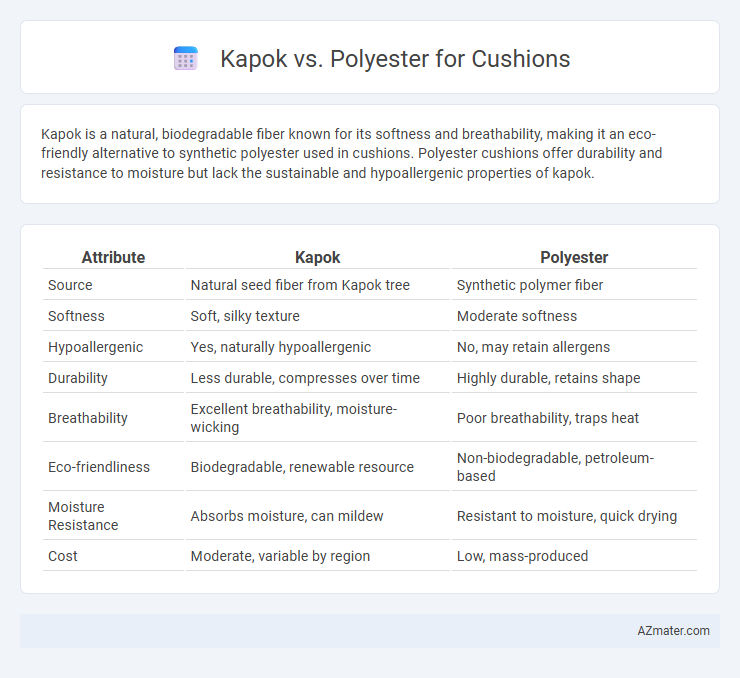Kapok is a natural, biodegradable fiber known for its softness and breathability, making it an eco-friendly alternative to synthetic polyester used in cushions. Polyester cushions offer durability and resistance to moisture but lack the sustainable and hypoallergenic properties of kapok.
Table of Comparison
| Attribute | Kapok | Polyester |
|---|---|---|
| Source | Natural seed fiber from Kapok tree | Synthetic polymer fiber |
| Softness | Soft, silky texture | Moderate softness |
| Hypoallergenic | Yes, naturally hypoallergenic | No, may retain allergens |
| Durability | Less durable, compresses over time | Highly durable, retains shape |
| Breathability | Excellent breathability, moisture-wicking | Poor breathability, traps heat |
| Eco-friendliness | Biodegradable, renewable resource | Non-biodegradable, petroleum-based |
| Moisture Resistance | Absorbs moisture, can mildew | Resistant to moisture, quick drying |
| Cost | Moderate, variable by region | Low, mass-produced |
Introduction to Kapok and Polyester for Cushions
Kapok fibers, harvested from the seed pods of the kapok tree, are naturally lightweight, biodegradable, and hypoallergenic, making them an eco-friendly alternative for cushion stuffing. Polyester, a synthetic fiber derived from petroleum, offers durability, water resistance, and cost-effectiveness, often used in commercial cushioning for its consistent support. Comparing kapok and polyester in cushions highlights the choice between sustainability and synthetic resilience, influencing comfort, environmental impact, and maintenance.
Natural Origins: What is Kapok?
Kapok is a natural fiber harvested from the seed pods of the kapok tree (Ceiba pentandra), known for its lightweight, biodegradable properties and soft, fluffy texture ideal for cushion filling. Unlike polyester, which is a synthetic material derived from petrochemicals, kapok is renewable and environmentally friendly, making it a sustainable choice for eco-conscious consumers. Its natural origins contribute to breathability and hypoallergenic qualities, enhancing comfort and indoor air quality in cushions.
Polyester Fiber: Synthetic Cushion Filling Explained
Polyester fiber is a widely used synthetic cushion filling known for its durability, lightweight properties, and resistance to moisture and mildew. It maintains consistent loft and shape over time, making cushions more resilient to wear and tear compared to natural fillings like kapok. The manufacturing process of polyester fiber allows for customizable density and firmness, enhancing comfort and support in various cushion applications.
Comfort Comparison: Kapok vs Polyester
Kapok fibers offer superior breathability and natural softness, making cushions exceptionally comfortable and hypoallergenic compared to polyester fills. Polyester cushions tend to retain heat and can feel firmer, providing less cushioning and breathability than kapok. The natural resilience of kapok also helps maintain loft and shape better over time, enhancing long-term comfort.
Breathability and Temperature Regulation
Kapok fibers offer superior breathability and natural temperature regulation due to their hollow, moisture-wicking structure, which allows air circulation and keeps cushions cool. Polyester cushions, while durable and moisture-resistant, tend to trap heat and reduce airflow, leading to less effective temperature control. Choosing kapok enhances comfort in warm climates by maintaining a cooler, drier cushion environment.
Sustainability and Environmental Impact
Kapok is a natural, biodegradable fiber harvested from the seed pods of the kapok tree, which requires no pesticides or fertilizers, making it a highly sustainable choice for cushions compared to polyester. Polyester, synthesized from petroleum, has a significant environmental footprint due to its reliance on fossil fuels and its non-biodegradable nature, contributing to microplastic pollution. Choosing kapok cushions supports eco-friendly practices by reducing waste and carbon emissions, enhancing sustainability in home textiles.
Durability and Maintenance
Kapok cushions offer moderate durability with natural fibers that resist compression but are prone to moisture absorption and mildew, requiring regular airing to maintain freshness. Polyester cushions provide superior durability, resisting wear, moisture, and stains, making them easier to clean and ideal for high-traffic usage areas. Choosing between Kapok and Polyester depends on balancing the need for natural material longevity with hassle-free maintenance.
Hypoallergenic Properties and Health Considerations
Kapok fibers are naturally hypoallergenic, resistant to dust mites and mold, making them an excellent choice for cushions for individuals with allergies or sensitive skin. Polyester cushions, though durable, can trap dust and allergens, potentially exacerbating respiratory issues and skin irritation. Choosing kapok cushions supports better indoor air quality and overall health due to their natural breathability and antimicrobial properties.
Price and Availability
Kapok cushions are typically more expensive due to the natural harvesting process and limited supply compared to polyester, which is widely mass-produced and available at a lower cost. Polyester cushions offer easier accessibility in various retail outlets and online stores, ensuring broad availability. The price difference is influenced by kapok's eco-friendly appeal and polyester's synthetic manufacturing efficiency.
Which is Better? Choosing the Right Cushion Filling
Kapok is a natural, biodegradable fiber that offers breathability and softness, making it ideal for eco-conscious consumers seeking hypoallergenic cushion fillings. Polyester, a synthetic fiber, provides durability, resilience, and affordability, often preferred for cushions requiring long-lasting shape retention and easy maintenance. Choosing the right cushion filling depends on priorities such as sustainability, comfort, and durability, with kapok excelling in natural comfort and polyester dominating in cost-effectiveness and longevity.

Infographic: Kapok vs Polyester for Cushion
 azmater.com
azmater.com